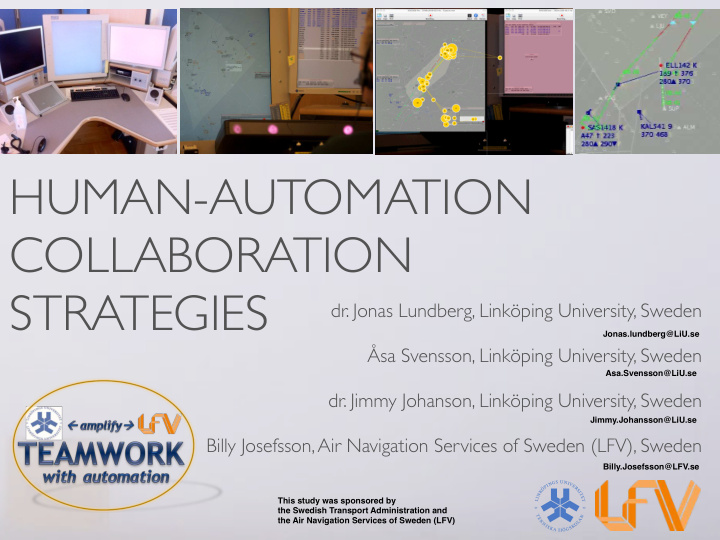



HUMAN-AUTOMATION COLLABORATION STRATEGIES dr. Jonas Lundberg, Linköping University, Sweden Jonas.lundberg@LiU.se Åsa Svensson, Linköping University, Sweden Asa.Svensson@LiU.se dr. Jimmy Johanson, Linköping University, Sweden Jimmy.Johansson@LiU.se Billy Josefsson, Air Navigation Services of Sweden (LFV), Sweden Billy.Josefsson@LFV.se This study was sponsored by the Swedish Transport Administration and the Air Navigation Services of Sweden (LFV)
SAFETY PROBLEM • Separation Incidents 2011-2012 in Swedish Air Space • Either ATC did not pay sufficient attention to the tools (should try Perhaps I should check one more time? harder) • Or the tools were not sufficiently clear (should be designed better)
Case study - to uncover basic human-automation collaboration strategies
CASE STUDY Scenarios with 12 fully licensed ATCOS with valid ratings 6 male, 6 female, 9-38 years of experience irregularities During 6 Planner 6 Executive verification-of- competence training Divided into four conditions • 3 Planner - overflight • 3 Planner - climb/descend • 3 Executive - overflight • 3 Executive - climb / descend Overflight and climb / descend areas MTCD was only used in overflight area
SITUATION AWARENESS Based on Lundberg (2015) Dimension Primary measure A process … Processes eye tracking SA, how? … of understanding what goes on in States uncertain dynamic situations…. SA, what? actions … through collaboration with automated Systems tools and other agents… SA, where? video/audio recordings Lundberg, J. (2015). Situation Awareness Systems, States and Processes: A holistic framework. Theoretical Issues in Ergonomics Science. doi: 10.1080/1463922X.2015.1008601.
SA Systems: Automation CONFLICT AND RISK DISPLAY
FLIGHT LEG SA Systems: Automation
INDICATORS SA Systems: Automation
SA Process: Eye tracking recording EPISODE ANALYSIS When a conflict becomes visible on CARD, then what does the ATCO do?
SA Process: Eye tracking recording EPISODE ANALYSIS GAZE PLOT based on eye tracking recording
SA Process: Eye tracking recording EPISODE ANALYSIS When a conflict becomes visible on CARD, then what does the ATCO do? ( What role does CARD and FLEG have in conflict detection?)
SA Process: Collaboration and coordination STRATEGIES • A: Rely primarily on the automation, examine conflicts as they emerge on MTCD • B: Rely primarily on an own independent scan, check MTCD now and then. • …. : Combinations, variations?
A. RELY ON AUTOMATION
VS. B: INDEPENDENT SCAN a. checking card first vs b. checking card AFTER examining the conflict
An ideal situation E. LOOKING AHEAD
… how could this result in separation infringements….? C. DELAY IN DETECTION 48 second delay
… how could this result in separation infringements….? D. SHORT TIME TO CONFLICT
…INFRINGEMENTS…? • A delay in conflict examination (C) • + short time to conflict (D) • could result in an infringement.
Recommend
More recommend